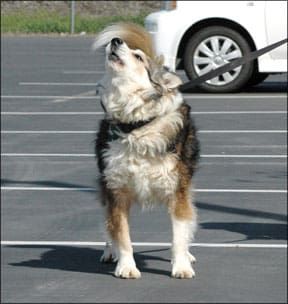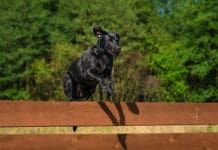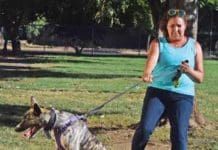Dog-reactive behavior can be alarming and frustrating for a dog owner, as well as damaging to the canine-human relationship. Most of us adopt our dogs with the hope of sharing them with the rest of the world – on walks, at family picnics, at events around town, and sometimes at canine competitions. It’s not quite as much fun when you have to leave your canine family member at home because he barks, leaps around, lunges at, maybe even tries to bite other dogs. Here are five things you can do when your reactive rover goes bonkers in public places:

288
1.) Stay calm. If you become angry, hysterical, loud, or violent, you only add to the stress that has put him over his emotional threshold. As horrifying as his display may be, your emotion only makes it worse for him. Try “square breathing”: breathe in for three seconds; hold it for three seconds; breathe out for three seconds; hold it for three seconds; repeat.
2.) Leave. When your dog is having a huge emotional outburst, the best thing you can do in that moment is take him away. He is emotionally out of control, and all your pleas to “sit” or “lie down” are fruitless; he literally is unable to process your cues. The thought-process part of his brain isn’t working.
3.) Create distance. If you can’t leave for some reason, at least put distance between your dog and any other dogs in the area. Most dogs have a “threshold distance” – a distance at which they are able to maintain self-control. It may be as close as 20 feet or as far as 100 yards – and it may vary somewhat from one day to the next. Find your dog’s threshold distance and try to stay at least that far away from other dogs.
4) Use a visual barrier. Most dog-reactive dogs are most stimulated by the sight of another dog. Try putting a visual barrier between your dog and whatever causes him to become aroused. You can use your own body, stepping between him and the others. Or, train him to step behind you and sit when he sees another dog at a distance. Look for a hedge you can step behind with your dog, or a wall, fence, or building that will block his sight. You can even carry an umbrella to pop open, to place in front of him to block his visual access to other dogs.
If his arousal is a reaction to the sound of other dogs, try MuttMuffs, available at safeandsoundpets.com, to dampen the volume of sounds he can hear. (Be careful! Neither will he be able to hear approaching vehicles, or other sounds that help to keep him safe).
5.) Teach him an emergency exit. Make this a fun game that you play when there aren’t other dogs present. Your cue should be something that lends itself to happy play, such as “Whee!” or “Run awaaay!” Teach it when your dog is walking with you on leash by saying the cue in a loud, happy, high voice and then making a 180-degree turn and running as fast as you can in the opposite direction for at least 20 feet. Your dog should be galloping happily after you.
When you stop, toss yummy treats, play tug, throw a ball for him to catch, or engage him in some other favorite play activity. The goal is to give him such a positive association with his “run away” cue that he doesn’t think about getting aroused by the sight of the dog who just popped out from behind a parked car. After you’ve taught him the game, you can use it when a dog suddenly appears inside his threshold distance.
Of course, the best solution of all for a seriously dog-reactive dog is to modify his behavior, either using classical counter-conditioning (See “Nuclear Reactors,” WDJ November 2003), or operant conditioning (See “Build Better Behavior,” May 2008 and “CAT Revisited,” December 2009). Then you’ll be able to go to that family picnic or agility trial, no worries!
Pat Miller, CPDT-KA, is WDJ’s Training Editor. Miller lives in Fairplay, Maryland, site of her Peaceable Paws training center. Pat is also author of many books on positive dog training.






